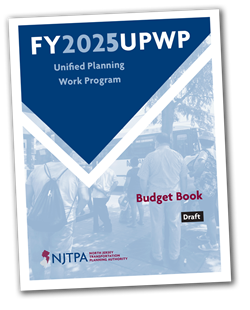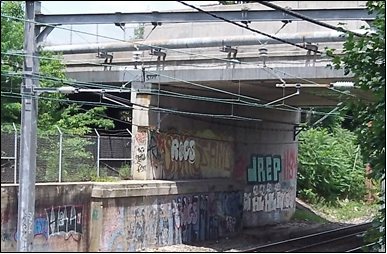March 2024
Posted: 3/18/2024 11:05:35 AM
 The NJTPA Board of Trustees approved a work program for the next fiscal year, which includes updating the Long Range Transportation Plan (LRTP), and launching three new pilot programs.
The NJTPA Board of Trustees approved a work program for the next fiscal year, which includes updating the Long Range Transportation Plan (LRTP), and launching three new pilot programs.
The Fiscal Year 2025 Unified Planning Work Program, which begins July 1, details the work of NJTPA’s Central Staff, its member agencies and the state’s eight transportation management associations.
The LRTP is one of the agency’s core documents. It sets a vision for the region’s transportation future and guides the NJTPA’s work. The Board is set to adopt the plan in September 2025. In tandem with this, Central Staff will also work to update the Transportation Improvement Program, or TIP, which is a four-year list of federally funded projects included in the LRTP. Staff will also lead a consultant effort to estimate the emissions impact of these projects, to ensure they do not have a negative impact on the region’s air quality. This is called the Air Quality Conformity Determination. This determination and the TIP will also go to the Board for consideration in September 2025.
The work program includes several new pilot programs:
- Complete Streets Conceptualization: This effort will provide consultant-supported planning and project development assistance to advance a local Complete Streets project that addresses community and regional goals regarding safety, accessibility, equitable access to employment and other destinations, access to public transportation, and reduction of single-occupancy vehicle trips. This study will also develop guidelines for a Complete Streets Conceptualization Program including project identification, prioritization and selection, the specific steps to complete the process, and final deliverables.
- Pedestrian Lighting Analysis: This effort will examine up to 26 locations across the NJTPA region. While only 25 percent of vehicle miles travelled occur at night, the nighttime pedestrian fatality rate is three times higher than during the day. Recommendations will be developed to improve lighting and pedestrian safety at each location. The reports prepared for each location can be used to advance projects through the NJTPA’s Local Safety Program.
- Intersection Control Evaluation: This effort was recommended in New Jersey’s last Strategic Highway Safety Plan update. It will help develop a performance-based approach for screening alternatives and identifying optimal geometric and traffic control solutions for high-crash intersections. Staff will work with the NJTPA subregions to select 15 locations for evaluation.
The work program also includes two Freight Concept Development studies, Southern Middlesex County North-South Truck Corridor Project in Cranbury and Monroe, Middlesex County; and Hanover Avenue Bridge Catenary Rail Clearance Project in Morris Plains, Morris County.
Several initiatives that began in FY 2024 will conclude in the next fiscal year, including the completion of Local Safety Action Plans for eight counties in the NJTPA region; a consultant-led effort to gather public input for the LRTP; demographics and travel analysis, and freight industry forecasts, which will be used for the LRTP update.
Posted: 3/15/2024 2:53:53 PM
 Two projects selected for the NJTPA’s next Freight Concept Development Program (FCDP) would address truck traffic in Southern Middlesex County and a bridge clearance issue in Morris County to allow more taller, industry standard freight trains to serve the area.
Two projects selected for the NJTPA’s next Freight Concept Development Program (FCDP) would address truck traffic in Southern Middlesex County and a bridge clearance issue in Morris County to allow more taller, industry standard freight trains to serve the area.
The NJTPA Board of Trustees approved up to $1.5 million in funding for the two Freight Concept Development Program Studies during its meeting March 11 following approval by the Project Prioritization Committee in February. The funding will commence in Fiscal Year 2025(which begins July 1, 2024). The two projects are:
Southern Middlesex County North-South Truck Corridor Project, Cranbury and Monroe, Middlesex County
This project advances the recommendation from the Southern Middlesex County Freight Movement Study, completed in June 2023 through the NJTPA’s Subregional Studies Program, to create a north-south truck corridor to mitigate the number of trucks traveling in residential areas.
 The current roadway network can cause trucks to travel on County Route 619 (Applegarth Road) or create confusion about the appropriate truck route, leading to trucks traveling into residential neighborhoods. Among the measures, recommended in the study are applying to the New Jersey Department of Transportation for truck restrictions on key local roads; installing new wayfinding signage for trucks; reconfiguring intersections to better accommodate truck movements, and reducing the speed limit on state Route 32 and standardizing the number of lanes in each direction. According to the study, Route 32 is considered a “truck crash hotspot.” The new truck route would be mostly parallel to the New Jersey Turnpike and County Route 619. It would add capacity and accommodate north-south traffic through Cranbury and Monroe.
The current roadway network can cause trucks to travel on County Route 619 (Applegarth Road) or create confusion about the appropriate truck route, leading to trucks traveling into residential neighborhoods. Among the measures, recommended in the study are applying to the New Jersey Department of Transportation for truck restrictions on key local roads; installing new wayfinding signage for trucks; reconfiguring intersections to better accommodate truck movements, and reducing the speed limit on state Route 32 and standardizing the number of lanes in each direction. According to the study, Route 32 is considered a “truck crash hotspot.” The new truck route would be mostly parallel to the New Jersey Turnpike and County Route 619. It would add capacity and accommodate north-south traffic through Cranbury and Monroe.
Hanover Avenue Bridge Catenary Rail Clearance Project, Morris Plains, Morris County
This project advances a recommendation from the 2013 Morris/Warren County Rail Corridor Study to explore alternatives for eliminating the rail clearance issue below the Hanover Avenue Bridge. Freight railroads use NJ TRANSIT’s Morristown Line, which has overhead catenary below the bridge that limits the height of rail cars that pass underneath. Once completed, the project will open the entire corridor from Phillipsburg to Morristown for taller, industry standard freight rail cars to travel and serve customers along the main line and several branch lines within Morris County.
More than 1,000 potential freight projects have been identified over the past decade in planning studies conducted in the NJTPA region, many of which do not have a clear path forward toward implementation. The NJTPA’s Freight Initiatives Committee in 2018 approved creating the Freight Concept Development Program, which included a process to identify and select projects to advance. The two projects were selected from among 27 candidate projects.
Posted: 3/13/2024 1:59:25 PM
Halfway through the five-year Infrastructure Investment and Jobs Act (IIJA), Erich Zimmermann laid out the challenges and changes ahead for reauthorization of the $1.2-trillion program to the NJTPA Board of Trustees.
Zimmermann, executive director of the National Association of Regional Councils (NARC), spoke before the Board during its bi-monthly meeting on March 11. The Washington, D.C.-based member organization includes regional councils, councils of governments (COGs), regional planning and development agencies, and metropolitan planning organizations (MPOs), and advocates for regional cooperation to address planning and development.
 “The tide in D.C. is starting to turn already, from focus on implementation to reauthorization," he said, noting that May 2024 is the halfway mark of the IIJA. “We’re facing a more interesting reauthorization than we usually do.”
“The tide in D.C. is starting to turn already, from focus on implementation to reauthorization," he said, noting that May 2024 is the halfway mark of the IIJA. “We’re facing a more interesting reauthorization than we usually do.”
The sheer size of the bill “makes it a different beast when we’re typically just talking about transportation,” he said, as the breadth of the program extends well beyond transportation. There will be big questions about which pieces of the IIJA are going to be preserved and which might be forgone.
Going forward, Zimmermann suggested shifting some discretionary programs into formula programs. “We're big proponents of formula funding, where money goes out and everybody across the nation gets some funding for whatever particular program,” he said.
While there are worthy discretionary grant programs, there are some challenges that come with those grants, including expensive and cumbersome application processes, he said. "At the end of the day, when you have an expensive application process, communities that are less resourced are going to have a harder time succeeding,” he said.
 He held up Safe Streets and Roads For All as an example of a discretionary grant that could become a formula program, where funding goes directly to local entities to meet safety needs. “We need to continue to not only bolster that but expand it, so everyone’s getting a piece of that pie, not just those that are able to get through the discretionary grant process,” Zimmermann said.
He held up Safe Streets and Roads For All as an example of a discretionary grant that could become a formula program, where funding goes directly to local entities to meet safety needs. “We need to continue to not only bolster that but expand it, so everyone’s getting a piece of that pie, not just those that are able to get through the discretionary grant process,” Zimmermann said.
“One thing we're going to need to do to show Congress we can support robust programs going forward is really accentuating the wins that came out of IIJA and that will continue to come out of this program.”
A recording of the March 11 Board of Trustees meeting can be accessed here.
Posted: 3/12/2024 8:56:27 AM
 Ocean County Commissioner John P. Kelly told fellow Board members that as NJTPA Chair, improving safety and accessibility along Route 9, one of the region’s most congested corridors will be his top priority.
Ocean County Commissioner John P. Kelly told fellow Board members that as NJTPA Chair, improving safety and accessibility along Route 9, one of the region’s most congested corridors will be his top priority.
“Our infrastructure needs to ensure that people can get to where they need to go safely and efficiently, regardless of their travel mode,” he said at the March 11 Board of Trustees meeting. “Reducing this congestion will also help improve air quality for residents in the communities along Route 9.”
The Board elected a new Executive Committee, including naming Commissioner Kelly Chair, at its January meeting.
Chairman Kelly noted that in addition to improving the flow of vehicles along Route 9, it’s important to also consider upgrades to make it safer for pedestrians and cyclists, particularly in Lakewood. He said he looks forward to working with the New Jersey Department of Transportation to explore solutions for the corridor. He noted that the NJTPA completed a study in 2016 that explored potential improvements to Route 9 in Lakewood and Toms River.
Improving safety, accessibility and air quality, and reducing congestion — all things Kelly said he would like to see accomplished for Route 9 — are among the NJTPA’s goals in its Long Range Transportation Plan. The NJTPA will be launching an update of that plan, which guides all its planning work, later this year, including extensive outreach to Board members, stakeholders, and the public.
Another key-theme in the long-range plan is resiliency, and Kelly said that is also an area he would like to focus on, noting that Route 9 is a critical evacuation route during natural disasters, such as hurricanes and forest fires.
“It’s critical that we harden our region’s infrastructure to withstand extreme weather events,” he said. “While this is particularly important in a coastal county like Ocean, it is increasingly an issue throughout our entire region.”
Posted: 3/7/2024 12:47:47 PM
 A partnership of agencies in the greater New York-New Jersey metropolitan area, including the NJTPA, submitted a Priority Climate Action Plan (PCAP) on March 1 as part of a multi-year grant to reduce greenhouse gas emissions (GHG) and other harmful air pollution in the region.
A partnership of agencies in the greater New York-New Jersey metropolitan area, including the NJTPA, submitted a Priority Climate Action Plan (PCAP) on March 1 as part of a multi-year grant to reduce greenhouse gas emissions (GHG) and other harmful air pollution in the region.
The PCAP is the initial step in fullfilling the terms of the Environmental Protection Agency’s (EPA) Climate Reduction Grant (CPRG), awarded in September. It includes a GHG inventory, emissions projections, proposed reduction measures, and an analysis of how the measures could benefit low-income and disadvantaged communities.
The plan identifies nine priority GHG reduction measures, aimed at addressing the largest sources of emissions in the region. These measures include:
- Zero emission passenger vehicle adoption
- Zero emission bus and truck adoption
- Alternative freight modes
- Travel demand management and reduction of VMT
- Maritime and air travel emissions
- Building electrification and energy efficiency
- Grid decarbonization
- Waste disposal reduction
- Additional cross-cutting measures
The next step will be to create a Comprehensive Climate Action Plan (CCAP) which is due in September 2025, two years from the date of the grant award. The comprehensive plan will include additional research, analysis, stakeholder engagement and community outreach to further develop measures that will help the region meet its emissions goals.
The CPRG is a nationwide grant program funded by the Inflation Reduction Act. The first phase provided $250 million in noncompetitive planning grants to states and other entities to develop both the PCAPs and CCAPs. With a PCAP in place, the states, counties and municipalities in the region can apply for $4.6 billion in competitive grants to implement priority measures. The deadline to apply for implementation grants is April 1.
To view the PCAP and learn more, visit bit.ly/NYNJClimatePlan